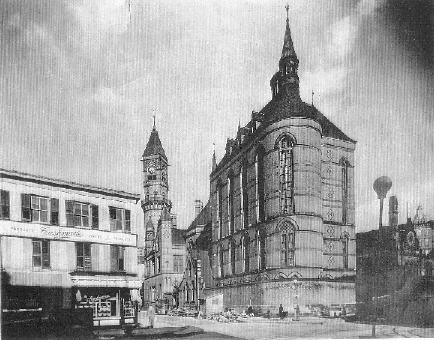
| Famous Cases and the Women's House of Detention |

|
Famous Cases and the Construction of the Women's House of Detention |
| The courthouse was briefly the center of national
attention in 1906, when Harry K. Thaw was tried here for the murder of
architect Stanford White (the infamous Girl in the Red Velvet Swing
case). White's firm, McKim, Mead and White, had, coincidentally,
designed 11 branch library buildings for The New York Public Library.
White's affair with chorus girl/model Evelyn Nesbit before her marriage to Thaw was the motive in this crime of passion. Thaw was eventually judged to be "insane" and was sent to an asylum until his release in 1915. This story was later immortalized by E.L. Doctorow in his book Ragtime. Earlier, in 1896, Stephen Crane, author of The Red Badge of Courage, testified in the courthouse on behalf of a woman he felt was unjustly arrested for prostitution. Crane related that he was "studying human nature" in the dicey Tenderloin area of the city when the alleged solicitation occurred. The woman in question, Dora Clark, was a friend of two chorus girls that Crane was interviewing for a newpaper article. Front page headlines the next day praised Crane's "chivalry and courage" for speaking out on behalf of the wrongly accused woman. A passage from Christopher Benfey's The Double Life of Stephen Crane tells this story in detail. In 1909, The Triangle Shirtwaist Company, on Washington Place, one block East of Washington Square in the Asch Building, was notorious for its tough labor policies: low wages, long hours, and annoying rules, which included a prohibition on speaking to one's neighbor at the workbench and a penalty of being sent home and losing half a day's pay for taking more time for a toilet break than the floor supervisor felt was necessary. The workers, in alliance with middle-class sympathizers, demonstrated and went on strike. The Triangle.s owners struck back aggressively. Pickets were verbally and physically harassed by hired thugs and the police, and dozens of strikers were arrested. To add insult to the injury of incarceration and fines, the arrested women were taken to Jefferson Market Courthouse and tried in Night Court, a tactic meant to intimidate strikers through association with the prostitutes whose cases usually filled the court's dockets at that time. "No nice girls go there," one arrested shirtwaist maker asserted. These intimidation tactics did not succeed. The striking women's spirits were not broken and great strides were achieved in their working conditions. Unfortunately, though, not enough changed for the better. The factory, famously and tragically, burned to the ground in 1911. 125 garment workers, most very young girls, died in the fire or were killed jumping from the high windows to the pavement below. By 1927 the courts were used solely for the trials of women, and in 1929 the market and co-ed prison were torn down and replaced by the Women's House of Detention, probably the only Art Deco prison in the world. Mae West was tried here soon after on obscenity charges when her Broadway play Sex became a target of the Society for the Suppression of Vice. West received a $500 fine, one day next door in the Women's House of Detention and nine days at the workhouse on Welfare Island (now Roosevelt Island). The House of Detention was razed in 1973 and replaced by a lovely community garden. |